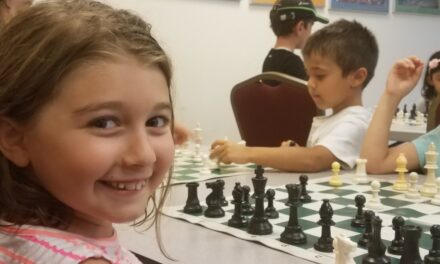Here is a game from the 2010 State Grade Championship that Bryan annotated exclusively for our website.
My round 4 opponent was Luc Lalonde, a strong 1700 player. I must
admit, i wasn’t expecting too much difficulty, even with black, but
Luc put up a good fight.
White: Luc Lalonde
Black: Bryan Hu
1.Nf3 Nf6
2.b3
Relatively rare. Normal, of course, would be either 2.c4, 2.g3, or 2.d4.
2… d6
3.d4 g6
4.Bb2 Bg7
5.e3 0-0
6.Be2
Personally, I would have preferred 6.Bd3.
6… Nbd7
7.0-0 Qe8?!
Not completely sure what I was doing. I had ideas of …e5, while avoiding shifting my rook to the e-file in favor of supporting a later …f5 in traditional King’s Indian style; however, any …e5 in the near future would be met by an exchange on e5 and then Ba3.
8.Nbd2 b6
Turning attention towards e4 and also highlighting why the white bishop would have rather been on d3 than e2, to keep an eye on e4. Playing Bd3 now would lose a tempo over playing it on the sixth move.
9.Nc4 Bb7
10.a4! Ne4
11.a5 e6
12.a6
An interesting strategy. With his pawn moves, White might now consider ideas like Na3-b5, forcing Black to uncomfortably defend the a7-pawn.
12…Bc6
13.Na3 f5
14.b4 Ndf6
Of course to free d7 for the bishop.
15.Ne1!
Planning f3 and a regrouping.
15…d5
16.f3 Nd6
17.Nd3
Heading to a nice hole on e5.
17…Bh6
Targeting the newly-made weakness at e3. This forces White into an awkward position.
18. Kf2 g5!
Black’s queen is coming to h5 and …g4 is on the way.
19.Rg1
Odd move. Possibly to have a useful rook if the g-file ever opens after …g4 and …gxf3.
19…Qh5
20.Ne5 Qh4+
Black flicks in a check before dealing with the attack on c6.
21.Kf1
(21.g3? Qxh2+ 22.Rg2 Nde4+! 23.fxe4 Ng4+! 24. Bxg4 fxg4+ 25. Bf3 Qh5 will win the piece back with Black up a pawn)
21…Be8?!
Here I missed a nice win with 21…Ng4! (similar to the note at white’s 21st move), as the threats on f2, h2, and down the f-file when White captures are too strong.
22.Rh1 g4
23.Qe1!
White is trying to simplify and hope to get to a salvageable ending.
23…Qxe1+
24.Kxe1 Bxe3
25.fxg4 Nfe4!
White’s pieces are all over the place and uncoordinated. Black’s minor pieces come swarming in.
26.Bf3 Bd2+
27.Ke2 Bxb4
28.Rhf1 Bxa3
Wins another pawn.
29.Bxa3 Bb5+
30.Nd3 Bxa6
31.gxf5
31. Bxd6 would be met by 31…Bxd3+ and 32…Nxd6.
31…exf5
If 31…Rxf5, 32.Bg4.
32.g4 Rfe8
33.Kd1 Nc4
White can’t avoid losing material.
34.gxf5 Ne3+
35.Ke2 Nxf1
36.Kxf1 Bxd3+
37. cxd3 Nd2+
38.Kf2 Nxf3
39.Kxf3
Black is winning, as he is up too much material.
39…Rac8
40.Rg1+ Kf7
41.Bc1 Rg8
42.Re1 Rce8
43.Be3 a5
44.Rc1 Re7
45.Rc6 a4
46.Bf4 a3
47.Bxc7 a2
48.Rc1 Ra8
0-1




